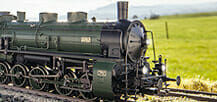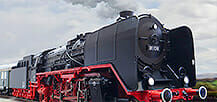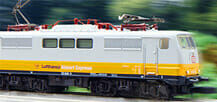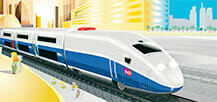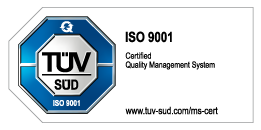Class E 71.1 Electric Locomotive
Road number E 71 26 enriched the still small Baden electric network for the Wiesen and Wehratal Line starting in 1929 as the Baden "Flat Iron" between Basle via Schopfheim and Zell or Bad Säckingen. It was placed into service in 1920 as road number EG 526 and it was part of the first regular procurement of electric locomotives for the Prussian State Railroad for freight train service. This locomotive was characterized by a modern propulsion design for that time using two trucks driven by coupling rods. It was initially used in the Central German network at Halle, and as early as 1929 road number E 71 26 went to Basle for use pulling passenger and freight trains. It remained there until its retirement on June 2, 1957.
Prototype: German Federal Railroad (DB) class E 71.1 electric locomotive. Bottle green basic paint scheme. Locomotive road number E 71 26. The locomotive looks as it did around 1954.
Most Important Facts
Sound demo| Article No. | 39771 |
|---|---|
| Gauge / Design type | H0 / 1:87 |
| Era | III |
| Kind | Electric Locomotives |
Highlights
- Completely new tooling.
- Especially intricate metal construction.
- Many separately applied details, such as external coolers for transformer oil.
- Cab lighting can be controlled digitally.
- mfx+ World of Operation decoder with extensive operation and sound functions.
- Buffer height conforms to NEM.
-
Product description
Model: The locomotive has an mfx+ digital decoder and extensive sound functions. It also has controlled high-efficiency propulsion with a flywheel, centrally mounted. The mechanism is powered using cardan shafts to both axles in each truck. Traction tires. Dual headlights and dual red marker lights change over with the direction of travel, will work in conventional operation, and can be controlled digitally. The headlights at Locomotive Ends 2 and 1 can be turned off separately in digital operation. When the headlights are turned off at both ends, then the switching light at both ends is on. The cabs have lighting and it can be controlled separately at both ends in digital operation. Maintenance-free warm white and red LEDs are used for the lighting. Grab irons are separately applied. The cab interiors are modelled. Both trucks are connected with each other using coupling rods. Brake hoses and imitation prototype couplers are included and can be installed on the locomotive. Length over the buffers 13.3 cm / 5-1/4".
A contemporary freight car set to go with this locomotive is also being produced under item number 48825 in a one-time series exclusively for Insider members.
This model can be found in a DC version in the Trix H0 assortment under item number 25771 exclusively for Trix Club members.
Find more Märklin explanation videos on our YouTube Channel
Spare parts for our articles can be found here in our spare parts search.
The class E 71.1 electric locomotive is being produced in 2022 in a one-time series only for Insider members.
-
Publications
- Special Imprint and Special Products - Product programme 2022/2023 - Sonderprospekt Insider 2 2022
-
Prototype information
As early as 1906, the Prussian State Railroad decided to electrify the long-distance line Magdeburg – Dessau – Leipzig – Halle, and in 1911, the decision was taken to electrify the Silesian mountain railroad between Görlitz and the Waldenburg coalfields. In July of 1912, the railroad management in Halle ordered new electric locomotives for operation in larger production runs, among them 18 B-B coupled units for freight service as road numbers EG 511-528 (later the class E 71). A subsequent order of nine additional locomotives followed the next year (road numbers EG 529-537). Road numbers EG 511 and 512 were put into operation in the spring of 1914 and road number EG 513 did not follow until the summer of 1915. The outbreak of World War I delayed additional construction of the units ordered. AEG did not deliver the rest, road numbers EG 514-537, until between 1920 and 1921. The DRG designated only road numbers EG 511 and 513-537 as road numbers E 71 11 and 13-37 in the fall of 1926, since road number EG 512 had to be retired in the same year after a serious accident. The E 71 showed a thoroughly modern design for the times: Its drive system was done with traction motors mounted half high in each truck, which were connected to the driving wheels using intermediate gears and slotted coupling rods. The two close-coupled trucks had the box-style superstructure supported using friction bearing plates and pivots with both cabs as well as a rounded hood section at both ends. The motor voltage was regulated by electro-pneumatic contactors in eleven continuous speed levels. Starting in 1923, all of these locomotives were based in Halle, but the class E 71 units soon no longer fulfilled the requirements due to increasing trainloads. The delivery of the new class E 75 starting in 1931 meant that the class E 71 units were no longer needed except for a few units. By 1932, the latter found a new home at Basle (road numbers E 71 11, 13, 14, 17, 22, 23, 25, 26, 29, 31, 32, 33, and 35). There they replaced the old Baden electric locomotives on the Wiesen and Wehratal Line and were quickly designated affectionately "Flat Irons" due to their appearance. These locomotives were equipped with improved traction motor cooling, electric train heating, as well as BBC safety running circuits to enable their use in Baden for passenger service with the maximum speed increased to 65 km/h / 41 mph. Between 1930 and 1946, road numbers E 71 11, 15-17, 20, 21, 23-25, 27, and 33-37 succumbed to retirement. After the founding of the DB in 1949 only nine units at Basle were still running (road numbers E 71 13, 14, 18, 19, 22, 26, 28, 29, and 32) on the Wiesen and Wehratal Line. Increasingly difficult spare parts procurement led starting in 1957 to replacement of these elderly units by the class E 32. Road numbers E 71 14, 18, 19, 22, and 26 were put into storage on June 2, 1957. The last four units were retired between November of 1957 and December of 1958. These road numbers have been preserved: E 71 19 (DB Museum Koblenz), E 71 28 (German Technology Museum Berlin) und E 71 30 (Dresden Transportation Museum).
-
Digital Functions
Control Unit Mobile Station Mobile Station 2 Central Station 1/2 Central Station 3/2*
Mobile Station 2**Headlight(s) Engineer’s cab lighting Electric locomotive op. sounds Locomotive whistle Direct control Engineer’s cab lighting Headlight(s): Cab2 End Whistle for switching maneuver Headlight(s): Cab1 End Sound of squealing brakes off Pantograph Sounds Sound of Couplers Engaging Blower motors Brake Compressor Letting off Air Conductor's Whistle Opening cab door Rail Joints Sanding Switching maneuver Switching range + switching light Surrounding sounds Special sound function * New features of the Central Station 2 (Part No. 60213, 60214 or 60215) with the software update 4.2
** New features of the Mobile Station 2 (Part No. 60657/66955) with the Software Update 3.55
Warning
ATTENTION: not for children under 15 years
